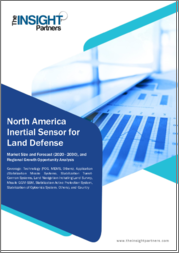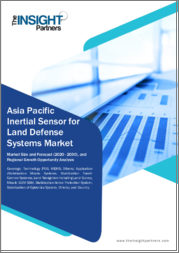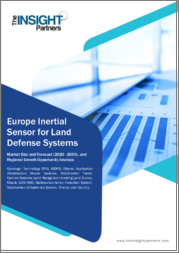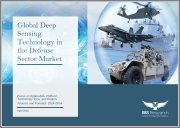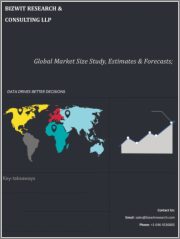
|
시장보고서
상품코드
1269733
세계의 군 및 방위용 센서 시장 규모 조사 및 예측 : 플랫폼별, 컴포넌트별, 용도별, 지역별 분석(2022-2029년)Global Military and Defense Sensor Market Size study & Forecast, by Platform, By Component, By Application, and Regional Analysis, 2022-2029 |
||||||
세계의 군 및 방위용 센서(Military and Defense Sensor) 시장은 2021년에 약 83억 달러로 평가되고 예측 기간(2022-2029년) 동안 5.8% 이상의 건전한 성장률로 성장할 것으로 예상됩니다.
군 및 방위용 센서는 무기, 항공기, 전자 가젯의 일부로 환경을 스캔하여 데이터를 수집하거나 주변의 변화를 감지합니다. 데이터를 분석하기 위해, 검색된 정보는 그 후 다른 전자 시스템(대부분 컴퓨터 프로세서)으로 전송됩니다. 레이더, 비행기, 미사일, 전투기 등 네비게이션, 무기 제어, 액티브 가이던스, 타겟 추적, 환경 인식 등 시스템에는 모두 군 및 방위용 센서가 사용되고 있습니다. 안개, 연기, 먼지도 전기 광학과 같은 센서를 사용하여 감지할 수 있습니다. 시장의 수요는 주로 군 및 방위 활동에 있어서 무인 시스템의 사용이 증가하고 있으며, 이들 시스템이 자율적이고 효과적으로 동작할 수 있도록 하기 위해 센서가 중요한 역할을 하고 있다는 점에 기인합니다. 또, 테러 그리고 전쟁의 위협이 높아짐에 따라 잠재적인 위협을 실시간으로 검출·식별할 수 있는 군 및 방위용 센서의 수요가 높아지고 있는 등 요인에 의해 견인되고 있습니다.
또한 군 및 방위비 증가는 시장 성장의 주요 촉진 요인으로 작용하고 있습니다. 스톡홀름 국제평화연구소(SIPRI)의 보고에 따르면 세계 군사 예산은 전년 대비 2.6% 증가했으며 2020년에는 1조 9,810억 달러에 달합니다. 2020년 군사 예산은 세계 GDP의 2.4%를 차지합니다. 이와 같이 세계 군사비의 급증은 드론 국방 시스템 등 뛰어난 방위 기술의 전개를 가속화하고 있습니다. 또한 사물인터넷(IoT), 마이크로 전기화학 시스템(소형기계·전자통합 디바이스), 인공지능(AI)의 개발이 이 분야의 새로운 전망을 열고 있습니다. 정부와 조직은 무기 시스템 및 관련 기술의 개발 및 이전을 규제하고 있으며, 향후 수년간 시장 성장에 유리한 기회를 제공하고 있습니다. 그러나 개발의 복잡성은 2022년부터 2029년까지의 예측 기간 동안 시장 성장을 제한하고 있습니다.
군 및 방위용 센서 시장 조사에서 고려된 주요 지역은 아시아 태평양 지역, 북미, 유럽, 중남미 및 기타 지역입니다. 북미는 주요 기업에 의한 새로운 군사전원 솔루션 개척을 위한 연구개발 활동에 많은 지출과 경량으로 에너지 효율적인 센서에 대한 요구 증가 등 이 지역에서 군용 센서 시장의 성장으로 수익면 에서 시장을 독점하고 있습니다. 한편, 유럽은 예측 기간 동안 가장 높은 성장률로 성장할 것으로 예상됩니다. 영국, 프랑스, 독일 등 국가들은 많은 방위 예산을 가지고 있으며, 이 지역 시장 성장을 견인하고 있는 등 요인이 존재합니다. 또한 정보·감시·정찰(ISR) 용도의 고도의 센서에 대한 수요 증가가 예측 기간 중 시장 성장을 급성장시키고 있습니다.
이 조사의 목적은 최근 몇 년 동안 다양한 부문와 국가 시장 규모를 밝히고 앞으로 수년간 시장 규모를 예측하는 것입니다. 이 보고서는 조사 대상 국가의 산업의 질적 및 양적 측면을 포착하도록 설계되었습니다.
또한 시장의 향후 성장을 규정하는 촉진 요인과 과제 등 중요한 측면에 대한 자세한 정보도 제공하고 있습니다. 또한 주요 기업의 경쟁 상황과 제품 제공에 대한 상세한 분석과 함께, 이해관계자가 투자할 수 있는 거시적 시장의 잠재적인 기회도 포함하고 있습니다.
목차
제1장 주요 요약
- 시장 스냅샷
- 전 세계·부문별 시장 추정 및 예측(2019-2029년)
- 군 및 방위용 센서 시장, 지역별(2019-2029년)
- 군 및 방위용 센서 시장, 플랫폼별(2019-2029년)
- 군 및 방위용 센서 시장, 컴포넌트별(2019-2029년)
- 군 및 방위용 센서 시장, 용도별(2019-2029년)
- 주요 동향
- 조사 방법
- 조사의 전제 조건
제2장 군 및 방위용 센서 시장 정의 및 범위
- 조사 목적
- 시장 정의 및 범위
- 조사 대상 범위
- 산업 진화
- 조사 대상 년도
- 환율
제3장 군 및 방위용 센서 시장 역학
- 군 및 방위용 센서 시장 영향 분석(2019-2029년)
- 시장 촉진 요인
- 군 및 방위비 증가
- 무인 시스템에 대한 수요 증가
- 테러리즘의 위협 증가
- 시장 과제
- 백신 개발의 복잡성
- 시장 기회
- IoT, AI, 마이크로 전기화학 시스템 개발
- 개발을 위한 정부의 대처
- 시장 촉진 요인
제4장 세계의 군 및 방위용 센서 시장 산업 분석
- Porter’s Five Forces
- 공급기업의 협상력
- 구매자의 협상력
- 신규 참가업체의 위협
- 대체품의 위협
- 경쟁 기업 간 적대 관계
- Porter’s Five Forces에 대한 미래적 접근법(2019-2029년)
- PEST 분석
- 정치적
- 경제적
- 사회적
- 기술적
- 주요 투자 기회
- 주요 성공 전략
- 산업 관계자 전망
- 애널리스트의 권고 및 결론
제5장 위험 평가 : COVID-19의 영향
- COVID-19가 산업에 주는 전체적인 영향에 대한 평가
- COVID-19 이전과 COVID-19 이후 시장 시나리오
제6장 군 및 방위용 센서 시장 : 플랫폼별
- 시장 스냅샷
- 군 및 방위용 센서 시장 : 플랫폼별, 실적-잠재력 분석
- 군 및 방위용 센서 시장 : 플랫폼별, 추정 및 예측(2019-2029년)
- 군 및 방위용 센서 시장, 서브 부문별 분석
- 육상
- 해상
- 공중
제7장 군 및 방위용 센서 시장 : 컴포넌트별
- 시장 스냅샷
- 군 및 방위용 센서 시장 : 컴포넌트별, 실적-잠재력 분석
- 군 및 방위용 센서 시장 : 컴포넌트별, 추정 및 예측(2019-2029년)
- 군 및 방위용 센서 시장, 서브 부문별 분석
- 소프트웨어
- 하드웨어
제8장 군 및 방위용 센서 시장 : 용도별
- 시장 스냅샷
- 군 및 방위용 센서 시장 : 용도, 실적-잠재력 분석
- 군 및 방위용 센서 시장 : 용도별, 추정 및 예측(2019-2029년)
- 군 및 방위용 센서 시장, 서브 부문별 분석
- 전투 작전
- 타겟 인식
- 전자전
- 통신 및 네비게이션
- 명령 및 제어
- 감시 및 모니터링
- 정보 및 정찰
제9장 군 및 방위용 센서 시장 : 지역별 분석
- 군 및 방위용 센서 시장, 지역별 시장 스냅샷
- 북미
- 미국
- 플랫폼별 추정 및 예측(2019-2029년)
- 컴포넌트별 추정 및 예측(2019-2029년)
- 용도별 추정 및 예측(2019-2029년)
- 캐나다
- 미국
- 유럽의 군 및 방위용 센서 시장 스냅샷
- 영국
- 독일
- 프랑스
- 스페인
- 이탈리아
- 기타 유럽
- 아시아 태평양의 군 및 방위용 센서 시장 스냅샷
- 중국
- 인도
- 일본
- 호주
- 한국
- 기타 아시아 태평양 지역
- 남미의 군 및 방위용 센서 시장 스냅샷
- 브라질
- 멕시코
- 기타 남미 지역
- 기타 지역
제10장 경쟁 정보
- 주요 시장 전략
- 기업 개요
- Thales Group
- 주요 정보
- 개요
- 재무(데이터의 입수가 가능한 경우만)
- 제품 개요
- 최근 동향
- BAE Systems plc.
- Raytheon Technologies
- Curtiss-Wright Corporation
- Honeywell International Inc.
- Esterline Technologies Corporation
- Kongsberg Gruppen
- TE Connectivity Ltd.
- Lockheed Martin Corporation
- Rock West Solutions Inc.
- Thales Group
제11장 조사 프로세스
- 조사 프로세스
- 데이터 마이닝
- 분석
- 시장 추정
- 검증
- 출판
- 조사의 특징
- 조사의 전제 조건
Global Military and Defense Sensor Market is valued at approximately USD 8.3 billion in 2021 and is anticipated to grow with a healthy growth rate of more than 5.8% over the forecast period 2022-2029. Military and defence sensors are part of a weapon, an aircraft, or an electronic gadget that scans its environment to gather data or detects changes in its surroundings. In order to analyze the data, the acquired information is subsequently transmitted to other electronic systems, often a computer processor. Radars, airplanes, missiles, battle, and other systems for navigation, weapon control, active guidance, target tracking, and environmental awareness all use military and defence sensors. Fog, smoke, and dust can also be detected using sensors such as electro-optical ones. The market demand is primarily driven by the factors such as the use of unmanned systems in military and defense operations is increasing, and sensors play a critical role in enabling these systems to operate autonomously and effectively, coupled with the growing threat of terrorism and asymmetric warfare has led to an increased demand for military and defense sensors that can detect and identify potential threats in real-time.
In addition, the increase in military and defense expenditure is acting as major driving factor for market growth. The Stockholm International Peace Research Institute (SIPRI) reported that the worldwide military budget has increased 2.6% year over year to reach at $1,981 billion in 2020. In 2020, the military budget accounted for 2.4% of the global GDP. Thus, a surge in global military expenditure has accelerated the deployment of excellent defense technologies, such as drone defence systems. Furthermore, The development of the internet of things (IoT), micro-electrochemical systems (miniature mechanical & electronics integrated devices), and artificial intelligence (AI) open up new prospects in the sector Governments and organizations implement regulations governing the development and transfer of weapons systems or related technologies are presenting lucrative opportunities for market growth over the forthcoming years. However, the complexity in the development of vaccines is restricting the market growth over the forecast period of 2022-2029.
The key regions considered for the Global Military and Defense Sensor Market study include Asia Pacific, North America, Europe, Latin America, and Rest of the World. North America dominated the market in terms of revenue, owing to the growth of the military sensors market in this region including significant expenditures in R&D activities for the development of new military power solutions by major companies and the rising need for lightweight and energy-efficient sensors. Whereas, Europe is also expected to grow at the highest growth rate over the forecasting period. Factors such as Countries such as the United Kingdom, France, and Germany have large defense budgets, which are driving the growth of the market in this region. The increasing demand for advanced sensors for intelligence, surveillance, and reconnaissance (ISR) applications are burgeoning the market growth in the forecasting years.
Major market players included in this report are:
- Thales Group
- BAE Systems plc.
- Raytheon Technologies
- Curtiss-Wright Corporation
- Honeywell International Inc.
- Esterline Technologies Corporation
- Kongsberg Gruppen
- TE Connectivity Ltd.
- Lockheed Martin Corporation
- Rock West Solutions Inc.
Recent Developments in the Market:
- In June 2022, A significant test of the company's Joint All Domain Command and Control architecture was conducted by Raytheon Intelligence & Space, a Raytheon Technologies subsidiary, in which it demonstrated its ability to gather information on a fictitious sea-based threat and then exchange targeting solutions with distributed defence systems across the Western Pacific Ocean. Radar and electronic intelligence sensors were used with Raytheon's Multi-Program Testbed (RMT), a converted Boeing 727, to define the fictitious threat. The data was quickly synthesised by onboard processors, who then transmitted a thorough targeting solution to tactical platforms.
- In September 2021, Thales Group and The National University of Singapore (NUS) have signed a Memorandum of Understanding (MoU) to kick off a two-year collaboration to develop and test quantum technologies for commercial applications. The Quantum Engineering Programme (QEP) in Singapore and Thales intend to progress quantum technologies and get the sector ready for their arrival through the MoU. Through their collaboration, Thales and QEP's industry and academic professionals will be able to test and assess transdisciplinary quantum security technologies. In the areas of developing novel materials and designing for quantum sensing, they will also look into possible research partnership prospects. Also, they will plan collaborative events such as seminars and conferences to share their knowledge and present the results of their research.
Global Military and Defense Sensor Market Report Scope:
- Historical Data 2019-2020-2021
- Base Year for Estimation 2021
- Forecast period 2022-2029
- Report Coverage Revenue forecast, Company Ranking, Competitive Landscape, Growth factors, and Trends
- Segments Covered Platform, Component, Application, Region
- Regional Scope North America; Europe; Asia Pacific; Latin America; Rest of the World
- Customization Scope Free report customization (equivalent up to 8 analyst's working hours) with purchase. Addition or alteration to country, regional & segment scope*
The objective of the study is to define market sizes of different segments & countries in recent years and to forecast the values to the coming years. The report is designed to incorporate both qualitative and quantitative aspects of the industry within countries involved in the study.
The report also caters detailed information about the crucial aspects such as driving factors & challenges which will define the future growth of the market. Additionally, it also incorporates potential opportunities in micro markets for stakeholders to invest along with the detailed analysis of competitive landscape and product offerings of key players. The detailed segments and sub-segment of the market are explained below.
By Platform:
- Land
- Naval
- Airborne
By Component:
- Software
- Hardware
By Application:
- Combat Operations
- Target Recognition
- Electronic Warfare
- Communication and Navigation
- Command and Control
- Surveillance and Monitoring
- Intelligence and Reconnaissance
By Region:
- North America
- U.S.
- Canada
- Europe
- UK
- Germany
- France
- Spain
- Italy
- ROE
- Asia Pacific
- China
- India
- Japan
- Australia
- South Korea
- RoAPAC
- Latin America
- Brazil
- Mexico
- ROLA
- Rest of the World
Table of Contents
Chapter 1. Executive Summary
- 1.1. Market Snapshot
- 1.2. Global & Segmental Market Estimates & Forecasts, 2019-2029 (USD Billion)
- 1.2.1. Military and Defense Sensor Market, by Region, 2019-2029 (USD Billion)
- 1.2.2. Military and Defense Sensor Market, by Platform, 2019-2029 (USD Billion)
- 1.2.3. Military and Defense Sensor Market, by Component, 2019-2029 (USD Billion)
- 1.2.4. Military and Defense Sensor Market, by Application, 2019-2029 (USD Billion)
- 1.3. Key Trends
- 1.4. Estimation Methodology
- 1.5. Research Assumption
Chapter 2. Global Military and Defense Sensor Market Definition and Scope
- 2.1. Objective of the Study
- 2.2. Market Definition & Scope
- 2.2.1. Scope of the Study
- 2.2.2. Industry Evolution
- 2.3. Years Considered for the Study
- 2.4. Currency Conversion Rates
Chapter 3. Global Military and Defense Sensor Market Dynamics
- 3.1. Military and Defense Sensor Market Impact Analysis (2019-2029)
- 3.1.1. Market Drivers
- 3.1.1.1. Increase in military and defense expenditure.
- 3.1.1.2. Increasing demand for unmanned systems.
- 3.1.1.3. Growing threat of terrorism.
- 3.1.2. Market Challenges
- 3.1.2.1. Complexity in the development of vaccines
- 3.1.3. Market Opportunities
- 3.1.3.1. Development of IoT, AI, Micro-Electro Chemical system.
- 3.1.3.2. Government initiatives for development.
- 3.1.1. Market Drivers
Chapter 4. Global Military and Defense Sensor Market Industry Analysis
- 4.1. Porter's 5 Force Model
- 4.1.1. Bargaining Power of Suppliers
- 4.1.2. Bargaining Power of Buyers
- 4.1.3. Threat of New Entrants
- 4.1.4. Threat of Substitutes
- 4.1.5. Competitive Rivalry
- 4.2. Futuristic Approach to Porter's 5 Force Model (2019-2029)
- 4.3. PEST Analysis
- 4.3.1. Political
- 4.3.2. Economical
- 4.3.3. Social
- 4.3.4. Technological
- 4.4. Top investment opportunity
- 4.5. Top winning strategies
- 4.6. Industry Experts Prospective
- 4.7. Analyst Recommendation & Conclusion
Chapter 5. Risk Assessment: COVID-19 Impact
- 5.1. Assessment of the overall impact of COVID-19 on the industry
- 5.2. Pre COVID-19 and post COVID-19 Market scenario
Chapter 6. Global Military and Defense Sensor Market, by Platform
- 6.1. Market Snapshot
- 6.2. Global Military and Defense Sensor Market by Platform, Performance - Potential Analysis
- 6.3. Global Military and Defense Sensor Market Estimates & Forecasts by Platform 2019-2029 (USD Billion)
- 6.4. Military and Defense Sensor Market, Sub Segment Analysis
- 6.4.1. Land
- 6.4.2. Naval
- 6.4.3. Airborne
Chapter 7. Global Military and Defense Sensor Market, by Component
- 7.1. Market Snapshot
- 7.2. Global Military and Defense Sensor Market by Component, Performance - Potential Analysis
- 7.3. Global Military and Defense Sensor Market Estimates & Forecasts by Component 2019-2029 (USD Billion)
- 7.4. Military and Defense Sensor Market, Sub Segment Analysis
- 7.4.1. Software
- 7.4.2. hardware
Chapter 8. Global Military and Defense Sensor Market, by Application
- 8.1. Market Snapshot
- 8.2. Global Military and Defense Sensor Market by Application, Performance - Potential Analysis
- 8.3. Global Military and Defense Sensor Market Estimates & Forecasts by Application 2019-2029 (USD Billion)
- 8.4. Military and Defense Sensor Market, Sub Segment Analysis
- 8.4.1. Combat Operations
- 8.4.2. Target Recognition
- 8.4.3. Electronic Warfare
- 8.4.4. Communication and Navigation
- 8.4.5. Command and Control
- 8.4.6. Surveillance and Monitoring
- 8.4.7. Intelligence and Reconnaissance
Chapter 9. Global Military and Defense Sensor Market, Regional Analysis
- 9.1. Military and Defense Sensor Market, Regional Market Snapshot
- 9.2. North America Military and Defense Sensor Market
- 9.2.1. U.S. Military and Defense Sensor Market
- 9.2.1.1. Platform breakdown estimates & forecasts, 2019-2029
- 9.2.1.2. Component breakdown estimates & forecasts, 2019-2029
- 9.2.1.3. Application breakdown estimates & forecasts, 2019-2029
- 9.2.2. Canada Military and Defense Sensor Market
- 9.2.1. U.S. Military and Defense Sensor Market
- 9.3. Europe Military and Defense Sensor Market Snapshot
- 9.3.1. U.K. Military and Defense Sensor Market
- 9.3.2. Germany Military and Defense Sensor Market
- 9.3.3. France Military and Defense Sensor Market
- 9.3.4. Spain Military and Defense Sensor Market
- 9.3.5. Italy Military and Defense Sensor Market
- 9.3.6. Rest of Europe Military and Defense Sensor Market
- 9.4. Asia-Pacific Military and Defense Sensor Market Snapshot
- 9.4.1. China Military and Defense Sensor Market
- 9.4.2. India Military and Defense Sensor Market
- 9.4.3. Japan Military and Defense Sensor Market
- 9.4.4. Australia Military and Defense Sensor Market
- 9.4.5. South Korea Military and Defense Sensor Market
- 9.4.6. Rest of Asia Pacific Military and Defense Sensor Market
- 9.5. Latin America Military and Defense Sensor Market Snapshot
- 9.5.1. Brazil Military and Defense Sensor Market
- 9.5.2. Mexico Military and Defense Sensor Market
- 9.5.3. Rest of Latin America Military and Defense Sensor Market
- 9.6. Rest of The World Military and Defense Sensor Market
Chapter 10. Competitive Intelligence
- 10.1. Top Market Strategies
- 10.2. Company Profiles
- 10.2.1. Thales Group
- 10.2.1.1. Key Information
- 10.2.1.2. Overview
- 10.2.1.3. Financial (Subject to Data Availability)
- 10.2.1.4. Product Summary
- 10.2.1.5. Recent Developments
- 10.2.2. BAE Systems plc.
- 10.2.3. Raytheon Technologies
- 10.2.4. Curtiss-Wright Corporation
- 10.2.5. Honeywell International Inc.
- 10.2.6. Esterline Technologies Corporation
- 10.2.7. Kongsberg Gruppen
- 10.2.8. TE Connectivity Ltd.
- 10.2.9. Lockheed Martin Corporation
- 10.2.10. Rock West Solutions Inc.
- 10.2.1. Thales Group
Chapter 11. Research Process
- 11.1. Research Process
- 11.1.1. Data Mining
- 11.1.2. Analysis
- 11.1.3. Market Estimation
- 11.1.4. Validation
- 11.1.5. Publishing
- 11.2. Research Attributes
- 11.3. Research Assumption






